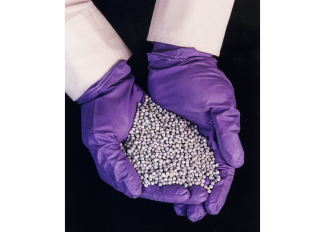NETL researchers are using analytical tools and modeling to determine the efficiency and cost effectiveness of technologies that can pull carbon dioxide (CO2) from ambient air and help reduce greenhouse gas levels in Earth’s atmosphere.
“Direct air capture (DAC) systems are essentially what plants and trees do every day through photosynthesis, except DAC technology can do it much faster, with a smaller land footprint, and deliver extracted CO2 in a pure, compressed form that can then be stored underground or reused,” said Tim Fout, a member of NETL’s Energy Process Analysis Team of the Strategic Systems Analysis and Engineering (SSAE) directorate.
NETL is well-positioned to lead the development of DAC technology. The Lab has been instrumental in advancing research to capture CO2 from the flue gas streams produced by power plants and other industries and store it permanently and safely in deep underground complexes and geologic reservoirs or use it as a feedstock to produce higher-value products such as chemicals and plastics.
DAC is an emerging technology that works by processing air from the atmosphere rather than a power plant or factory flue gas to capture CO2 emitted from multiple sources, thereby addressing both current and legacy emissions. DAC has been identified as an important tool to meet the Biden Administration’s goals calling for a carbon emission-free electricity sector by 2035 and economy-wide net-zero emissions by 2050.
As the technology gains traction, Fout and his colleagues have undertaken techno-economic analyses and case studies to ensure that researchers advancing DAC innovations are pursuing optimal routes for success.
“The CO2 in the atmosphere is much more diluted than, for instance, flue gas from a power station or a cement plant. This contributes to higher energy needs and costs for direct air capture as compared to other CO2 capture technologies and applications,” Fout said.
Using advanced process software modeling, simulation and optimization techniques, the team, part of the NETL Strategic Systems Analysis and Engineering directorate, is generating process material and energy balances, which enable equipment sizing and cost estimating.
While researchers are at work refining and developing DAC technologies, information from these analyses ensure that they are applying their skills to the most worthwhile tasks to keep their research on a successful path toward commercialization.
Such analyses also offer system-level estimates for emerging technology performance and costs at the commercial scale. This information helps make a case for investment in continued development and identifies areas where research and development efforts can achieve the most significant, economical improvements.
Results obtained from NETL’s techno-economic analyses are used to guide research and ensure advanced technologies are on target to meet U.S. Department of Energy goals and provide the most benefit to the American people.
“Our success is founded on collaboration and teamwork. NETL researchers such as Alex Zoelle, Jessica Valentine and many others have made critical contributions as we continue with our important work to advance the development of DAC technology,” said Travis Shultz, supervisor, Energy Process Analysis Team.
There are two main types of DAC technologies under investigation today to meet climate goals. These technologies operate under the same premise: selective removal of CO2 from ambient air by contact with chemical liquid solvents or a modified surface (chemical solid sorbents). These systems have dissimilar temperature requirements, which impacts the energy required to operate them. In general, state-of-the-art liquid solvent systems require 900 degrees C (1652 degrees F) to release captured CO, whereas state-of-the-art solid sorbent systems require 80 degrees C to 120 degrees C (176 to 248 degrees F).
When ambient air reaches the solvent or sorbent capture media, the CO2 in the air becomes fixated in a carbonate or carbamate bond within the capture media. The carbon is liberated from the capture media through application of heat or other energy input, producing high-purity CO2 and renewed solvent or sorbent.
However, different DAC systems have very different optimal configurations and operational conditions. Techno-economic analyses can help developers of DAC technologies make crucial decisions, including how to balance the capacity of a sorbent or solvent with other factors such as the amount and cost of energy required for operation, solvent or sorbent cost, and pressure drop, among others.
Fout explained the Energy Process Analysis Team is completing case studies that review how adjusting solvent and sorbent temperatures, carbon extraction capacities and other parameters impact costs and efficiency of DAC technologies.
In additional to a techno-economic review, emerging technologies such as DAC need to undergo a life cycle greenhouse gas analysis. NETL uses life cycle analysis (LCA) as a tool for evaluating energy technology and policy options such as the environmental burdens of extracting and converting energy resources to useful energy, comparing emerging and commercial production pathways, and informing research and development strategies to improve environmental performance.
Fout’s colleague, Tim Skone, senior environmental engineer on the NETL SSAE’s Energy Systems Analysis Team, leads LCA research. According to Skone, “DAC technology enables the removal of CO2 directly from our atmosphere and when that captured CO2 is permanently prevented from being released to the atmosphere it results in carbon negative emissions — a critical technology to help meet climate goals for deep decarbonization. LCA is one of the tools used by NETL to assess the life cycle environmental performance of decarbonization solutions.”
Much of NETL’s DAC-related systems work focuses on reviewing and comparing energy requirements, costs and environmental implications associated with using various solvents and sorbents with other techniques to maximize CO2 extraction, which will guide research to implement cost-effective solutions to reduce levels of greenhouse gas.
NETL is a U.S. Department of Energy national laboratory that drives innovation and delivers technological solutions for an environmentally sustainable and prosperous energy future. By leveraging its world-class talent and research facilities, NETL is ensuring affordable, abundant and reliable energy that drives a robust economy and national security, while developing technologies to manage carbon across the full life cycle, enabling environmental sustainability for all Americans.




